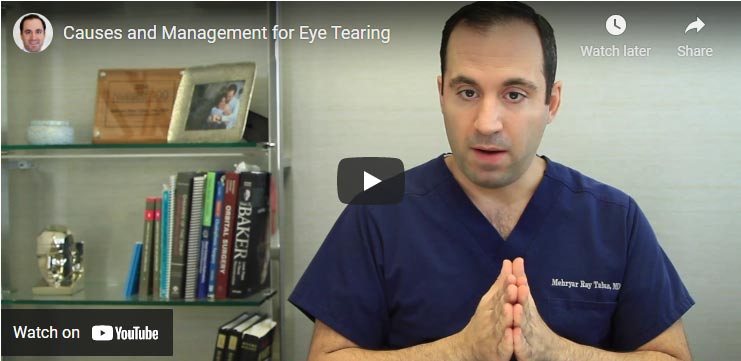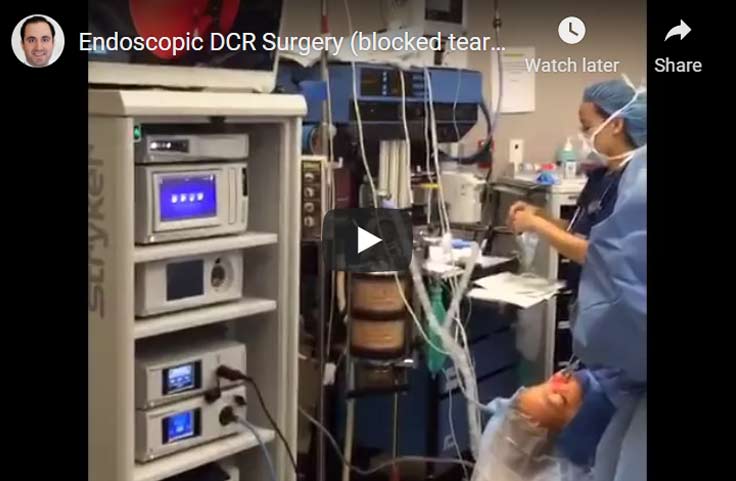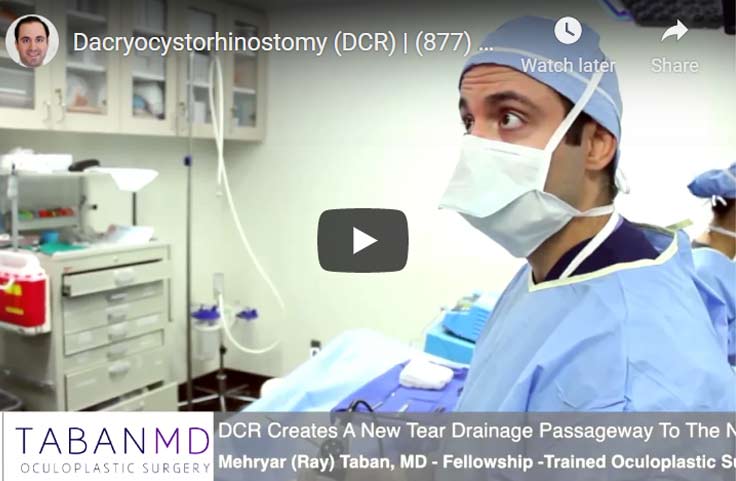Tearing & Lacrimal (Tear Duct) System (DCR Surgery)
The tearing system is both simple and complex. The tear film is composed of many different critical components, each made by a different eyelid gland/structure. It is designed to coat the eyeball to protect it and provide the essential clarity for vision (by light refraction). A smooth tear film not only depends on the tear glands but also on the tear drainage system, which consists of the eyelids and tear drainage duct system. If there is any disturbance of the tear film, patients can experience blurry vision, irritation, and excess tearing.
Excess Tearing Overview
Patients who experience tearing or epiphora either have a problem with producing tears or tear drainage as a result of one or more of the following:
- Dry eyes
- Blepharitis
- Eyelid malposition (ectropion, entropion, eyelid retraction)
- Nasolacrimal duct (tear duct) obstruction (congenital and acquired)
- Defective drainage of tears

What Causes Watery Eyes?
Dry Eyes
As odd as it sounds, the most common cause of tearing is dry eyes. Age, menopause, and various inflammatory conditions (including blepharitis or rosacea) can decrease tear production, resulting in eye dryness, irritation, and redness. This irritation causes the brain to send signals to the lacrimal tear duct glands to make emergency tears (reflex tearing). As a result, the eyes become watery, but they are flushed with tears that are meant to help wash away irritants from the eye rather than to hydrate them. This dryness and tearing can fluctuate throughout the day.
Certain tasks, such as reading or watching TV, that make someone focus more and blink less will cause the eyes to get dryer, activating the tear ducts. Wind and dry weather are also common causes of eye dryness.
Lower Eyelid Malposition and Laxity (Droopy Lower Eyelids)
Lower eyelid malposition and laxity can also cause excess tearing. If the lower eyelid sits too low relative to the eye, tears will well-up and eventually run down the cheek. The tears will also evaporate faster because the eye is more exposed. Severe lower eyelid laxity can lead to ectropion, where the eyelid rotates outward.
Once again, patients experience a cycle of dry eye and excess tearing. Entropion, on the other hand, causes direct irritation from the lashes poking the eyes. Surgery is usually necessary to correct these conditions.
Insufficient Drainage
Another common cause of excess tearing is nasolacrimal duct (tear duct) blockage. Normally, tears are made in the lacrimal gland and drain into the nose through small holes in the nasal portion of the eyelids called the punctum. A blockage anywhere from the punctum to the bony lacrimal canal in the nose can cause the tears to backup and run down the cheek.
An obstruction of the tear ducts may occur due to numerous reasons (aging, trauma, inflammatory conditions, medications, and tumors) and cause numerous signs and symptoms ranging from wateriness or tearing to discharge, swelling, pain, and infection. At times, it can lead to dacryocystitis (infection of the tear duct system).
Excess Drainage
Another common cause of excess tearing is nasolacrimal duct (tear duct) blockage. Normally, tears are made in the lacrimal gland and drain into the nose through small holes in the nasal portion of the eyelids called the punctum. A blockage anywhere from the punctum to the bony lacrimal canal in the nose can cause the tears to backup and run down the cheek.
An obstruction of the tear ducts may occur due to numerous reasons (aging, trauma, inflammatory conditions, medications, and tumors) and cause numerous signs and symptoms ranging from wateriness or tearing to discharge, swelling, pain, and infection. At times, it can lead to dacryocystitis (infection of the tear duct system).
When is Tear Duct Surgery Necessary for Excess Tearing?
If the tearing is caused by dryness or irritation, then that specific problem may be addressed by using over-the-counter artificial tears or medications which decreases inflammation in tear glands and encourages natural tear production to resume.
However, if the tearing or epiphora is related to a blockage in the tear duct drainage system, then surgery is usually necessary.
Nasolacrimal duct (tear duct) blockage is treated with a bypass surgery called dacryocystorhinostomy (DCR surgery). A DCR is performed by creating a new tear drainage passageway from the lacrimal sac into the nose, bypassing the obstruction to the tear duct. A silicone stent may be placed temporarily to keep the new bypass passageway open.
Many surgeons perform an external DCR, in which an incision is made in between the eye and the nose. Dr. Taban performs DCR surgery from the inside of the nose, endoscopically, not requiring a skin incision, which does not leave a scar and results in much quicker recovery. This approach is called endoscopic (or endonasal) DCR surgery.
In rare cases, the blockage may be in the canaliculi system. In these rare cases, a permanent bypass tube made of glass (Jones tube) may be necessary, which allows direct drainage of the tears from the eye into the nose.


Read Dr. Taban’s article about Blocked Tear Duct Related to Facial Asymmetry & Septal Deviation
Treatment for Excess Drainage
In some rare cases, excess tearing may occur when the natural tears drain away too quickly. Dr. Taban may be able to treat the condition by placing tiny punctal plugs into the openings of the lacrimal tear ducts. The plugs help prevent the tears from draining away, allowing them to hydrate and protect the surface of the eye. Depending on the patient, temporary punctal plugs made of collagen may be inserted in order to determine whether plugging the ducts is the best solution. The collagen will safely dissolve over time and the skilled oculoplastic surgeon can determine whether to insert longer-lasting plugs or to take a different approach to treating the excess tearing.
To learn more about Tear Drain Plugging (punctal plugs), read Dr. Taban’s article from the Comprehensive Ophthalmology Update.
Read Dr. Taban’s article about Punctal Plugs for Dry Eyes
Before & After Photos of Oculoplastic Surgeries
What to Expect During DCR Surgery
Surgery is usually performed under general anesthesia in an outpatient surgery center. As with most oculoplastic procedures, the recovery is quick and painless except for a “black eye” for a few days. As discussed earlier, Dr. Taban uses a minimally invasive endoscopic technique (endoscopic endonasal DCR) through the nose without any outside skin incision, with much quicker recovery and lack of scar.
Learn more about DCR surgeries (dacryocystorhinostomy) from AAO.org.
Contact the LA Oculoplastic Surgery Experts!
To better understand the cause of your eye tearing and the best treatment options available (including a possible tear duct blockage needing DCR surgery), contact Dr. Taban to schedule your initial consultation in our offices in greater Los Angeles area (Beverly Hills or Santa Barbara).
Next, read about Eyelid Laceration Surgery.
I needed surgery (DCR) as I had tear duct obstructions … I visited 4 doctors in total before selecting Dr. Taban. … Dr. Taban performs endoscopic DCRs. … I am happy to report that after 7 months, the procedure with Dr. Taban is still a success! … Thank you, Dr. Taban, for letting me wear eye makeup once again!






